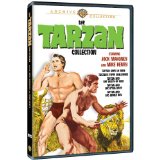| Reviews & Columns |
|
Reviews DVD TV on DVD Blu-ray 4K UHD International DVDs In Theaters Reviews by Studio Video Games Features Collector Series DVDs Easter Egg Database Interviews DVD Talk Radio Feature Articles Columns Anime Talk DVD Savant Horror DVDs The M.O.D. Squad Art House HD Talk Silent DVD
|
DVD Talk Forum |
|
|
| Resources |
|
DVD Price Search Customer Service #'s RCE Info Links |
|
Columns
|
|
|
Tarzan Collection Starring Jock Mahoney & Mike Henry, The
Warner Archive // Unrated // February 19, 2013
List Price: $59.99 [Buy now and save at Amazon]
The Movies:
When I was growing up in the 70's a local station used to show Tarzan and other jungle adventure movies every Sunday morning at 9 am under the Jungle Action banner. I started watching because there was nothing else on besides televangelists at that time, but it soon became something I looked forward to. (I still remember how upset I was when Jungle Action was replaced with Shirley Temple Theater.) The thing that I quickly came to realize is that Tarzan movies are known commodity: pick just about any film staring the Lord of the Jungle and you'll get an implausible, but rip-roaring fun adventure. Watching one is a great way to enjoy a couple of hours.
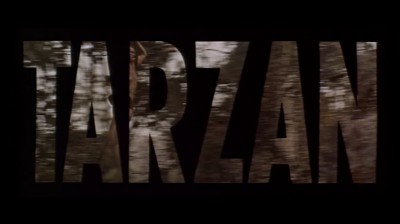
That's definitely true of the Tarzan Collection put out by the Warner Archive Collection. It's a set of five Tarzan films made between 1962 and 1968 featuring Jock Mahoney and then Mike Henry as the King of the Apes. Not only that, but these films would be end of the classic Tarzan movies. He wouldn't be featured in a film (aside from a movie made from edited TV shows) for nearly a decade and a half. The next time he'd grace the silver screen would be in 1981's Tarzan, the Ape Man and what's even worse than the long delay is that top billing was given to the actress who played Jane (Bo Derek).
When producer Sy Weintraub bought the rights to the franchise in 1958, he made some immediate changes. Tarzan no longer spoke in broken Pidgin English and Jane was removed from the series. Tarzan became more of and adventurer, and in the five films in this collection he travels the world helping out those in need.
The first movie in this set is the freshman appearance of Jock Mahoney in the lead role. Mahoney played a villain in the previous Tarzan film (1960's Tarzan the Magnificent) and impressed the producer so much that he landed the job.
Tarzan Goes toIndia
Having been called toIndia
Once there, the beautiful Princess Kamara relates the problem: a hydroelectric dam is nearing completion and when it's finished it will provide electricity for irrigation to a large area, but there's a large number of elephants trapped in the valley that can't climb the mountains to escape the flood waters. There is one passage that they could use, but it will be closed in a couple of days and the herd is being led be a rouge elephant that can't be controlled. Tarzan is the only one who could possibly save the pachyderms.
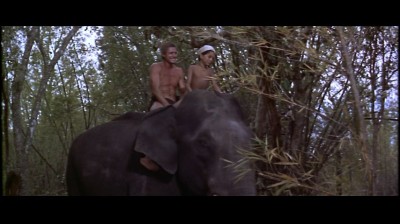
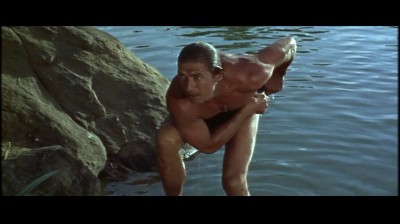
Taking a tour of the dam project, Tarzan butts heads with the wonderfully villainous lead engineer, Bryce (Leo Gordon), an avid big game hunter who doesn't care for neither animal nor human life, just getting his project completed before the monsoon rains start. Tarzan heads out to the jungle to find the herd and encounters "Jai the Elephant Boy," an orphan who owns a powerful elephant and won't leave the valley. He's sure his pet is so strong that he can fight the onrushing water. (My guess is that he was raised on The Iliad and loved the part where Achilles attacks theXanthus River
The first thing that strikes viewers about this film is that they've moved production off of the back lot and actually went to India to film the movie. This helps the franchise a great deal as they're able to do things that just couldn't be accomplished in and aroundHollywood
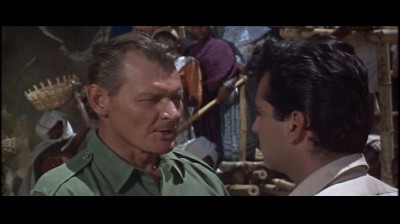
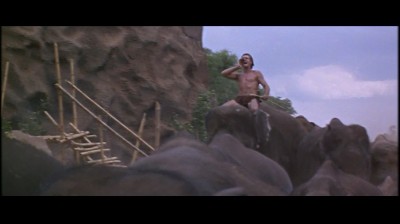
Jock Mahoney, who was a highly accomplished stuntman before turning to acting, creates a Tarzan that's a bit different from what has come before, and that's not necessarily a bad thing. He speaks English well and uses complete sentences, something that was started earlier in the franchise, but it's nice to see it carried on.
Mahoney is also an older Tarzan (he is the oldest actor to play the role on the silver screen) and he's not as muscular as his predecessor. While this has bothered some fans, it actually works well with the script (in both this and the following film). This is a Tarzan who has been around for a while and it both wiser and more thoughtful. He's still strong and agile, but he considers a problem before acting.
The only thing that really drags the film down is Tarzan's juvenile side-kick, Jai the Elephant Boy. The character comes across as irritating and obnoxious rather than cute and endearing. It's too bad that he mars an otherwise fun and enjoyable Tarzan adventure.
Tarzan's Three Challenges (1963):
The spiritual leader of the people is dying and has named a youth named Kashi as his successor. That doesn't sit well with Khan, the leader's brother (Woody Strode) who plans to kill the child and assume the throne himself.
So Tarzan (played by Jock Mahoney... his second and last appearance in the role) is summoned toThailand
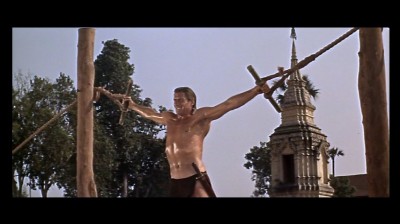
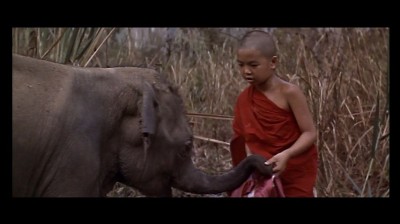
Once there, the holy men aren't sure that the man before them is really Tarzan the Ape Man and submit him to a series of trails to prove his worth. Surprisingly, these three challenges of the title actually only take up a few minutes of screen time, and then it's off across the country to get Kashi to the capital, but Khan doesn't plan to make it easy for him.
Like the previous movie, this one features a more cerebral and thoughtful Tarzan. He teaches Kashi along the way about violence and death, and serves as a friend as much as a guard. There is plenty of action, make no mistake. The film ends with a duel to the death between Tarzan and Khan that involves a foot race, bungee jumping into a river and ultimately a knife battle on a rope lattice above pots of boiling liquid.
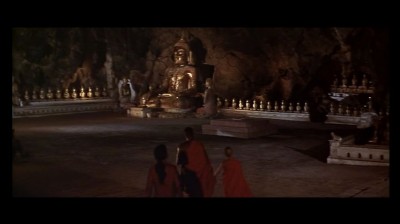
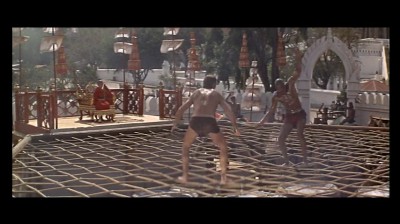
Filmed on location once again, the settings are a bit bland at times (much to the time they're just walking through bursh) but the temples and people are authentic. There's a big parade/celebration near the end, at it was quite an elaborate staging.
One last word on Jock Mahoney: he's a very good Tarzan, but he doesn't really look the part. I was surprised when doing research for this review that many people claimed that Mahoney was hired in order to get back to the franchise's roots and what Edgar Rice Burroughs originally envisioned for the character. While this may very well have been producer Sy Weintraub understanding of the Tarzan from the books, it wasn't accurate. As Burroughs described his most famous character in the first book, Tarzan of the Apes, he was incredibly strong: "Though but ten years old he was fully as strong as the average man of thirty, and far more agile than the most practiced athlete ever becomes. And day by day his strength was increasing." When he was fully grown, he was described thus:
It's pretty clear that the author was describing a man who looked very formidable.
In any case, near the end of filming this movie, Jock Mahoney came down with dysentery (reportedly after swimming in a polluted river) and lost a lot of weight. It took him 18 months to recover and through mutual agreement he was let out of his contract.
Tarzan and theValley of Gold
For the new Tarzan it was decided to go with someone more muscular and fit, and LA Rams Linebacker Mike Henry was selected. Henry really looks the part and is incredibly buff, and he filled the role well. However things had changed in the three years since the last movie: Bond-mania had struck.
Arriving intoMexico
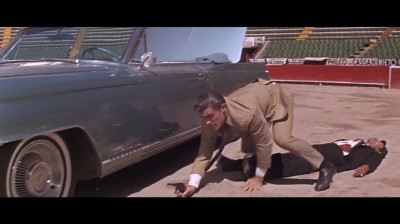
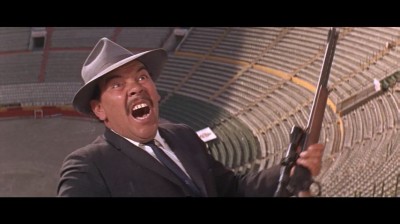
This sounds like a spy movie, doesn't it? The trappings of the spy genre continue to expand before we finally get to the jungle. Tarzan meets the local authorities where he finally gets an explanation: There is an international criminal, Augustus Vinero (David Opatoshu), who heard of a small boy, Ramel (Manuel Padilla Jr.), who is supposedly from the legendaryValley of Gold
Ramel managed to escape and he's being hidden on a farm by a friend of Tarzan's. By the time they arrive there, it's too late. Vinero's men have killed everyone and kidnapped the boy. The police offer Tarzan everything at their disposal to bring Vinero to justice and announce that they'll have 50 men there in the morning. Tarzan refuses their offer... that's too many men to movie quickly and quietly. When they ask him what he wants he replies with one of the better lines in any Tarzan film: "I'll need a good rope, a hunting knife, and a soft piece of leather." And he's right, that's pretty much all he needs.
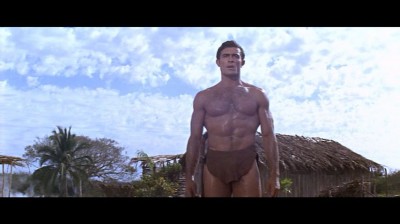
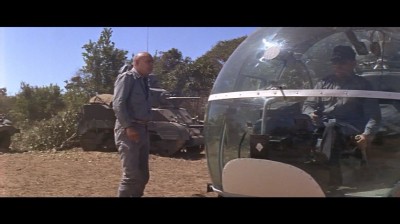
This film hasn't aged as well as the others in the series, but it's still a lot of fun. Trying to cash in on the popularity of James Bond was a mistake and results in some of the film's more goofy moments. The gun battle at the beginning of the movie just seems out of place, and Vinero would right in on the set of an Austin Powers movie. When people "upset" him, he gives them an expensive watch that explodes about a minute after it has been put on, and he's quite willing to blow someone up who works for him just because they have the audacity to ask for their pay. Having Tarzan fire a Browning Machine Gun (one of those heavy tripod-mounted things) from the hip and drive a tank makes him seem more like a resourceful spy than the Lord of the Jungle.
In any case, even though they're trying to cash in on the popularity of spy movies, this is still a good flick. Mike Henry seems at home in the jungle and cuts an imposing figure as he's swinging through the trees. The action, while a bit over the top, is still enjoyable. Who cares if it's a bit unrealistic to have Tarzan take out a helicopter from the ground? It's still cool. His taunting of his rival via a two-way radio is fun too. Overall it has a different feel from the earlier movies, but it's still worth watching. (And it makes me wonder how a Bond movie staring Mike Henry would have turned out.)
Tarzan and theGreat River
Since turning Tarzan into a Bond-like character didn't work it was decided that the franchise really needed some comic relief. This took the form of borscht belt comic and Hollywood Squares personality Jan Murray. He plays Captain Sam, the owner of a small, old riverboat that's been hired to take a shipment of desperately needed medicine up the Amazon for Dr. Ann Philips (Diana Millay, Dark Shadows). Also living on the boat is Pepe (Manuel Padilla Jr. who played Jai in the 1966 Tarzan TV series), an orphan that Sam has taken under his wing.
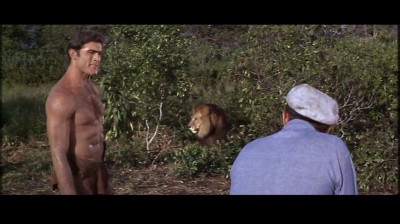
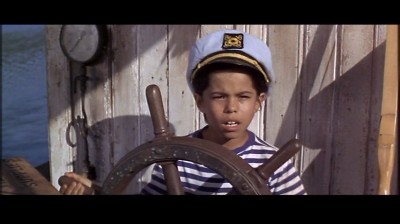
Complicating this idyllic existence is Barcuna (Rafer Johnson) the leader of an evil cult. His men have been conquering Indian villages and enslaving the people that they don't kill. He's using the slaves to mine diamonds, for reasons that aren't really explored. When a friend of Tarzan's who has been making trouble of Barcuna ends up dead, the jungle man heads off into the Amazon rain forest to settle things once and for all. After saving Captain Sam and Pepe from an ambush by Barcuna's men, Tarzan joins the group to protect them, and eventually Dr. Philips.
This would have been a much better film if they had made Captain Sam a straight character. His shtick doesn't fit in with the movie at all, and what's worse is that it's not funny. The banter between Sam and Pepe is supposed to be humorous and cute, but it's just dumb. A typical joke:
Sam: This boat isn't as young as she used to be.
Pepe: Neither are you Captain Sam!
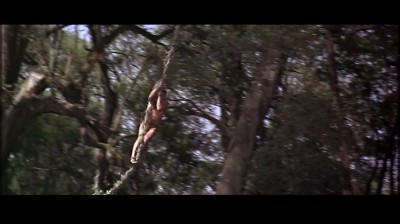
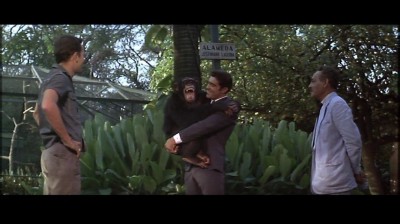
This hokum took up too much time in what would otherwise have been a pretty good film.
Tarzan and the Jungle Boy (1968):
The final film in this collection has Tarzan returning to his roots:Africa . Though it was filmed in Brazil (and a lot of footage was reused from the previous two pictures) Tarzan and the Jungle Boy feels a lot like an old Johnny Weissmuller-era film, though it does have its pitfalls.
The film gets off to a great start with the two sons of a tribal leader competing for the right to become chief when their father dies. Buhara (Edward Johnson) and Nagambi (Rafer Johnson) are evenly matched in the contest until Nagambi cheats and tries to kill his brother and is deemed unfit to lead. Once their father dies however (moments after the contest has ended) Nagambi ambushes his brother, ties him to the ground, and leaves him for the lions.
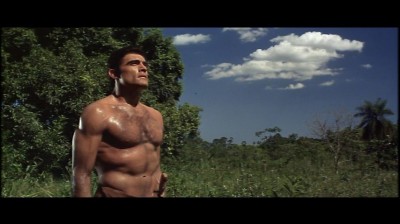
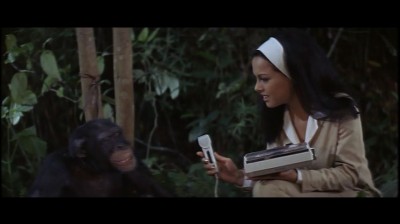
Buhara has some help however, in the form of Erik, an Anglo child who was lost in the jungle six years ago. Erik rescues the wounded chief and tries to tend to him while also dodging Nagambi and his men.
Meanwhile Tarzan is searching for Erik (future soap opera star Steven Bond) too, after a pushy photojournalist, Myrna Claudel (Aliza Gur), informs him that there's a young boy fending for himself in the jungle. The jungle king searches by himself, but Myrna pays a guide to sneak her into the forbidden area where Erik has been rumored to live. It's up to Tarzan to save the real tribal chief as well as Myrna from the evil Nagambi as well as locating the lost jungle boy.
There's a lot that works with this movie. They got rid of the comic relief (with the slight exception of Cheeta) and spy aspects and made a straight Tarzan flick. They include all of the trappings: friendly jungle animals to assist Tarzan, an attractive female lead, an evil villain to challenge the jungle king, and some great action scenes. The only problem is that it doesn't work quite as well as it should. There are a few storylines that are all competing for screen time, which means that Tarzan doesn't play a big of a role as he should. On top of that there's a lot of walking a jungle scenes, which makes the film feel a bit padded.
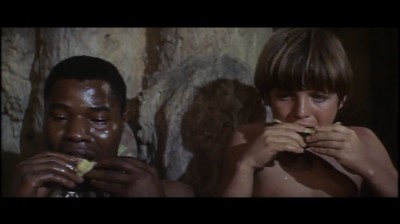
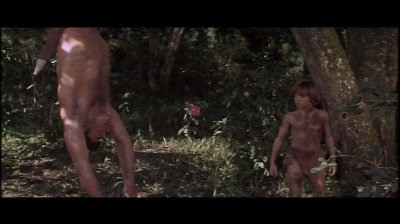
Mike Henry had enough of playing the role by the time production on this film wrapped. He was supposed to be the lead in the Tarzan TV series but declined. (Ron Ely would end up playing the role.) During his three films, which were shot back-to-back on location, he suffered from dysentery, was bitten by a chimp (which needed 20 stitches), got food poisoning, and a disease of the liver. He ended up suing producer Sy Weintraub for "maltreatment, abuse, and working conditions detrimental to my health and welfare."
And so ends the classic run of Tarzan, a film series that can trace its origins back over 35 years to 1932's Tarzan the Ape Man staring Johnny Weissmuller, the man who would make the Tarzan name synonymous with action and adventure.
The two channel audio is pretty decent across the five titles. There is a hiss that's pretty evident in the background of Tarzan and the Great River, but aside from that the soundtrack sounds pretty good for films as old as these.
Video:
The original 2.35 : 1 aspect ratio has been preserved for all of the films, which is great. After seeing these as pan-and-scan hack jobs on TV, it's wonderful to see the entire image. The picture is generally fine. While none of these has been restored, the level of detail is nice and the colors look good. There is some dirt and spots on the prints, especially at the beginning of the films, but it's never distracting or excessive.
Extras:
Unfortunately, there are no extras.
Final Thoughts:
A quintet of fun jungle action flicks, the Tarzan Collection is well worth checking out. Several of the films are very good and none of them are actually bad. Even the lesser entries feature some great action scenes and some fun adventure. If you're a Tarzan fan this is a no-brainer. Highly Recommended.
When I was growing up in the 70's a local station used to show Tarzan and other jungle adventure movies every Sunday morning at 9 am under the Jungle Action banner. I started watching because there was nothing else on besides televangelists at that time, but it soon became something I looked forward to. (I still remember how upset I was when Jungle Action was replaced with Shirley Temple Theater.) The thing that I quickly came to realize is that Tarzan movies are known commodity: pick just about any film staring the Lord of the Jungle and you'll get an implausible, but rip-roaring fun adventure. Watching one is a great way to enjoy a couple of hours.

That's definitely true of the Tarzan Collection put out by the Warner Archive Collection. It's a set of five Tarzan films made between 1962 and 1968 featuring Jock Mahoney and then Mike Henry as the King of the Apes. Not only that, but these films would be end of the classic Tarzan movies. He wouldn't be featured in a film (aside from a movie made from edited TV shows) for nearly a decade and a half. The next time he'd grace the silver screen would be in 1981's Tarzan, the Ape Man and what's even worse than the long delay is that top billing was given to the actress who played Jane (Bo Derek).
When producer Sy Weintraub bought the rights to the franchise in 1958, he made some immediate changes. Tarzan no longer spoke in broken Pidgin English and Jane was removed from the series. Tarzan became more of and adventurer, and in the five films in this collection he travels the world helping out those in need.
The first movie in this set is the freshman appearance of Jock Mahoney in the lead role. Mahoney played a villain in the previous Tarzan film (1960's Tarzan the Magnificent) and impressed the producer so much that he landed the job.
Tarzan Goes to
Having been called to
Once there, the beautiful Princess Kamara relates the problem: a hydroelectric dam is nearing completion and when it's finished it will provide electricity for irrigation to a large area, but there's a large number of elephants trapped in the valley that can't climb the mountains to escape the flood waters. There is one passage that they could use, but it will be closed in a couple of days and the herd is being led be a rouge elephant that can't be controlled. Tarzan is the only one who could possibly save the pachyderms.


Taking a tour of the dam project, Tarzan butts heads with the wonderfully villainous lead engineer, Bryce (Leo Gordon), an avid big game hunter who doesn't care for neither animal nor human life, just getting his project completed before the monsoon rains start. Tarzan heads out to the jungle to find the herd and encounters "Jai the Elephant Boy," an orphan who owns a powerful elephant and won't leave the valley. He's sure his pet is so strong that he can fight the onrushing water. (My guess is that he was raised on The Iliad and loved the part where Achilles attacks the
The first thing that strikes viewers about this film is that they've moved production off of the back lot and actually went to India to film the movie. This helps the franchise a great deal as they're able to do things that just couldn't be accomplished in and around


Jock Mahoney, who was a highly accomplished stuntman before turning to acting, creates a Tarzan that's a bit different from what has come before, and that's not necessarily a bad thing. He speaks English well and uses complete sentences, something that was started earlier in the franchise, but it's nice to see it carried on.
Mahoney is also an older Tarzan (he is the oldest actor to play the role on the silver screen) and he's not as muscular as his predecessor. While this has bothered some fans, it actually works well with the script (in both this and the following film). This is a Tarzan who has been around for a while and it both wiser and more thoughtful. He's still strong and agile, but he considers a problem before acting.
The only thing that really drags the film down is Tarzan's juvenile side-kick, Jai the Elephant Boy. The character comes across as irritating and obnoxious rather than cute and endearing. It's too bad that he mars an otherwise fun and enjoyable Tarzan adventure.
Tarzan's Three Challenges (1963):
The spiritual leader of the people is dying and has named a youth named Kashi as his successor. That doesn't sit well with Khan, the leader's brother (Woody Strode) who plans to kill the child and assume the throne himself.
So Tarzan (played by Jock Mahoney... his second and last appearance in the role) is summoned to


Once there, the holy men aren't sure that the man before them is really Tarzan the Ape Man and submit him to a series of trails to prove his worth. Surprisingly, these three challenges of the title actually only take up a few minutes of screen time, and then it's off across the country to get Kashi to the capital, but Khan doesn't plan to make it easy for him.
Like the previous movie, this one features a more cerebral and thoughtful Tarzan. He teaches Kashi along the way about violence and death, and serves as a friend as much as a guard. There is plenty of action, make no mistake. The film ends with a duel to the death between Tarzan and Khan that involves a foot race, bungee jumping into a river and ultimately a knife battle on a rope lattice above pots of boiling liquid.


Filmed on location once again, the settings are a bit bland at times (much to the time they're just walking through bursh) but the temples and people are authentic. There's a big parade/celebration near the end, at it was quite an elaborate staging.
One last word on Jock Mahoney: he's a very good Tarzan, but he doesn't really look the part. I was surprised when doing research for this review that many people claimed that Mahoney was hired in order to get back to the franchise's roots and what Edgar Rice Burroughs originally envisioned for the character. While this may very well have been producer Sy Weintraub understanding of the Tarzan from the books, it wasn't accurate. As Burroughs described his most famous character in the first book, Tarzan of the Apes, he was incredibly strong: "Though but ten years old he was fully as strong as the average man of thirty, and far more agile than the most practiced athlete ever becomes. And day by day his strength was increasing." When he was fully grown, he was described thus:
His straight and perfect figure, muscled as the best of the ancient Roman gladiators must have been muscled, and yet with the soft and sinuous curves of a Greek god, told at a glance the wondrous combination of enormous strength with suppleness and speed.
A personification, was Tarzan of the Apes, of the primitive man, the hunter, the warrior. With the noble poise of his handsome head upon those broad shoulders, and the fire of life and intelligence in those fine, clear eyes, he might readily have typified some demigod of a wild and warlike bygone people of his ancient forest.
A personification, was Tarzan of the Apes, of the primitive man, the hunter, the warrior. With the noble poise of his handsome head upon those broad shoulders, and the fire of life and intelligence in those fine, clear eyes, he might readily have typified some demigod of a wild and warlike bygone people of his ancient forest.
It's pretty clear that the author was describing a man who looked very formidable.
In any case, near the end of filming this movie, Jock Mahoney came down with dysentery (reportedly after swimming in a polluted river) and lost a lot of weight. It took him 18 months to recover and through mutual agreement he was let out of his contract.
Tarzan and the
For the new Tarzan it was decided to go with someone more muscular and fit, and LA Rams Linebacker Mike Henry was selected. Henry really looks the part and is incredibly buff, and he filled the role well. However things had changed in the three years since the last movie: Bond-mania had struck.
Arriving into


This sounds like a spy movie, doesn't it? The trappings of the spy genre continue to expand before we finally get to the jungle. Tarzan meets the local authorities where he finally gets an explanation: There is an international criminal, Augustus Vinero (David Opatoshu), who heard of a small boy, Ramel (Manuel Padilla Jr.), who is supposedly from the legendary
Ramel managed to escape and he's being hidden on a farm by a friend of Tarzan's. By the time they arrive there, it's too late. Vinero's men have killed everyone and kidnapped the boy. The police offer Tarzan everything at their disposal to bring Vinero to justice and announce that they'll have 50 men there in the morning. Tarzan refuses their offer... that's too many men to movie quickly and quietly. When they ask him what he wants he replies with one of the better lines in any Tarzan film: "I'll need a good rope, a hunting knife, and a soft piece of leather." And he's right, that's pretty much all he needs.


This film hasn't aged as well as the others in the series, but it's still a lot of fun. Trying to cash in on the popularity of James Bond was a mistake and results in some of the film's more goofy moments. The gun battle at the beginning of the movie just seems out of place, and Vinero would right in on the set of an Austin Powers movie. When people "upset" him, he gives them an expensive watch that explodes about a minute after it has been put on, and he's quite willing to blow someone up who works for him just because they have the audacity to ask for their pay. Having Tarzan fire a Browning Machine Gun (one of those heavy tripod-mounted things) from the hip and drive a tank makes him seem more like a resourceful spy than the Lord of the Jungle.
In any case, even though they're trying to cash in on the popularity of spy movies, this is still a good flick. Mike Henry seems at home in the jungle and cuts an imposing figure as he's swinging through the trees. The action, while a bit over the top, is still enjoyable. Who cares if it's a bit unrealistic to have Tarzan take out a helicopter from the ground? It's still cool. His taunting of his rival via a two-way radio is fun too. Overall it has a different feel from the earlier movies, but it's still worth watching. (And it makes me wonder how a Bond movie staring Mike Henry would have turned out.)
Tarzan and the
Since turning Tarzan into a Bond-like character didn't work it was decided that the franchise really needed some comic relief. This took the form of borscht belt comic and Hollywood Squares personality Jan Murray. He plays Captain Sam, the owner of a small, old riverboat that's been hired to take a shipment of desperately needed medicine up the Amazon for Dr. Ann Philips (Diana Millay, Dark Shadows). Also living on the boat is Pepe (Manuel Padilla Jr. who played Jai in the 1966 Tarzan TV series), an orphan that Sam has taken under his wing.


Complicating this idyllic existence is Barcuna (Rafer Johnson) the leader of an evil cult. His men have been conquering Indian villages and enslaving the people that they don't kill. He's using the slaves to mine diamonds, for reasons that aren't really explored. When a friend of Tarzan's who has been making trouble of Barcuna ends up dead, the jungle man heads off into the Amazon rain forest to settle things once and for all. After saving Captain Sam and Pepe from an ambush by Barcuna's men, Tarzan joins the group to protect them, and eventually Dr. Philips.
This would have been a much better film if they had made Captain Sam a straight character. His shtick doesn't fit in with the movie at all, and what's worse is that it's not funny. The banter between Sam and Pepe is supposed to be humorous and cute, but it's just dumb. A typical joke:
Sam: This boat isn't as young as she used to be.
Pepe: Neither are you Captain Sam!


This hokum took up too much time in what would otherwise have been a pretty good film.
Tarzan and the Jungle Boy (1968):
The final film in this collection has Tarzan returning to his roots:
The film gets off to a great start with the two sons of a tribal leader competing for the right to become chief when their father dies. Buhara (Edward Johnson) and Nagambi (Rafer Johnson) are evenly matched in the contest until Nagambi cheats and tries to kill his brother and is deemed unfit to lead. Once their father dies however (moments after the contest has ended) Nagambi ambushes his brother, ties him to the ground, and leaves him for the lions.


Buhara has some help however, in the form of Erik, an Anglo child who was lost in the jungle six years ago. Erik rescues the wounded chief and tries to tend to him while also dodging Nagambi and his men.
Meanwhile Tarzan is searching for Erik (future soap opera star Steven Bond) too, after a pushy photojournalist, Myrna Claudel (Aliza Gur), informs him that there's a young boy fending for himself in the jungle. The jungle king searches by himself, but Myrna pays a guide to sneak her into the forbidden area where Erik has been rumored to live. It's up to Tarzan to save the real tribal chief as well as Myrna from the evil Nagambi as well as locating the lost jungle boy.
There's a lot that works with this movie. They got rid of the comic relief (with the slight exception of Cheeta) and spy aspects and made a straight Tarzan flick. They include all of the trappings: friendly jungle animals to assist Tarzan, an attractive female lead, an evil villain to challenge the jungle king, and some great action scenes. The only problem is that it doesn't work quite as well as it should. There are a few storylines that are all competing for screen time, which means that Tarzan doesn't play a big of a role as he should. On top of that there's a lot of walking a jungle scenes, which makes the film feel a bit padded.


Mike Henry had enough of playing the role by the time production on this film wrapped. He was supposed to be the lead in the Tarzan TV series but declined. (Ron Ely would end up playing the role.) During his three films, which were shot back-to-back on location, he suffered from dysentery, was bitten by a chimp (which needed 20 stitches), got food poisoning, and a disease of the liver. He ended up suing producer Sy Weintraub for "maltreatment, abuse, and working conditions detrimental to my health and welfare."
And so ends the classic run of Tarzan, a film series that can trace its origins back over 35 years to 1932's Tarzan the Ape Man staring Johnny Weissmuller, the man who would make the Tarzan name synonymous with action and adventure.
The DVDs:
Audio:The two channel audio is pretty decent across the five titles. There is a hiss that's pretty evident in the background of Tarzan and the Great River, but aside from that the soundtrack sounds pretty good for films as old as these.
Video:
The original 2.35 : 1 aspect ratio has been preserved for all of the films, which is great. After seeing these as pan-and-scan hack jobs on TV, it's wonderful to see the entire image. The picture is generally fine. While none of these has been restored, the level of detail is nice and the colors look good. There is some dirt and spots on the prints, especially at the beginning of the films, but it's never distracting or excessive.
Extras:
Unfortunately, there are no extras.
Final Thoughts:
A quintet of fun jungle action flicks, the Tarzan Collection is well worth checking out. Several of the films are very good and none of them are actually bad. Even the lesser entries feature some great action scenes and some fun adventure. If you're a Tarzan fan this is a no-brainer. Highly Recommended.
|
| Popular Reviews |
| Sponsored Links |
|
|
| Sponsored Links |
|
|
| Release List | Reviews | Shop | Newsletter | Forum | DVD Giveaways | Blu-Ray | Advertise |
|
Copyright 2024 DVDTalk.com All Rights Reserved. Legal Info, Privacy Policy, Terms of Use,
Manage Preferences,
Your Privacy Choices | |||||||









